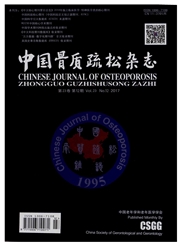

 中文摘要:
中文摘要:
目的采用核素“^99mTc-MDP”骨显像半定量检测方法评估骨质疏松与骨生物力学的相关性。方法取雌性实验新西兰兔进行肌肉注射地塞米松磷酸钠针剂(DX)制作兔骨质疏松动物模型,设正常对照组(A组),骨质疏松模型组(B组,肌肉注射DX量2mg/kg,每周2次)和骨量减少模型组(C组,肌肉注射DX量1mg/kg,每周1次),造模时间为6周。第7周时行“^99mTc-MDP”骨骼显像,取松质骨部位(腰椎、股骨头、膝关节)、密质骨部位(股骨中段)与第4尾椎的感兴趣区(Rou的比值。同时进行腰椎X、CT摄片、骨组织病理学、骨密度、骨生物力学、骨骼形态计量、血清骨碱性磷酸酶(BALP)、骨钙素(BGP)实验检测。采用SPSS13.0统计软件进行方差分析和组间t检验分析。结果7周时骨组织病理切片显示:A组股骨头的骨小梁排列规则,没有骨质破坏;与A组比较,B组则表现为股骨头关节表面软骨破坏,骨小梁稀疏、断裂现象。核素“^99mTc-MDP”骨骼显像ROI比值、BALP、BGP等功能性指标升高(P〈0.05),同时见骨生物力学和骨密度等形态学指标均降低(P〈0.05);C组骨病理切片仅见骨小梁略有稀疏现象,在“^99mTc-MDP”骨骼显像中,除股骨中段摄取放射性ROI比值不增高外,松质骨部位摄取放射性与BALP、BGP均升高,骨生物力学出现降低(P〈0.05),但骨密度等形态学指标显示轻度改变(P〉0.05)。结论核素“^99mTc-MDP”骨骼显像能够灵敏显示早期骨代谢异常的影像结果,当在早期骨量减少期(C组)时,仅松质骨部位骨组织摄取骨骼显像剂的比值升高,而密质骨部位摄取骨显像剂变化不明显,血清BALP、BGP也出现增高,但骨密度尚没有明显降低,实际骨生物力学已经开始降低,此时干预治疗是预防骨折的最佳方案。
 英文摘要:
英文摘要:
Objective To evaluate the correlation between osteoporosis and bone biomechanics using a semi-quantitative method of ^99mTc-MDP bone scintigraphy. Methods In order to establish rabbit osteoporosis model, female New Zealand rabbits were selected and given intramuscular injection of dexamethasone (DX). Rabbits were divided into 3 groups: normal control model ( Group A) , osteoporosis model ( Group B, with intramuscular injection of 2 mg/kg DX twice a week) , and bone mass loss model ( Group C, with intramuscular injection of lmg/kg DX once a week). The whole modeling process lasted for 6 weeks. At the 7^th week, 99mTc-MDP bone scintigraphy was performed to evaluate the ROI ratio of the spongy bone (the lumbar spine, the femoral head, and the knee) , the compact bone (the middle femur), and the 4^th coccygeal vertebra. Meanwhile, lunabar spine X-ray imaging, CT, bone pathology, BMD, bone biomechanics, bone morphology, and serum BALP and BGP test were performed. A SPSS 13.0 software was used for statistical variance analysis and t-test. Results The bone tissue pathology test at the 7th week showed that trabecular of the femur in Group A lined regularly and no bone mass destruction was observed. Compared with that in Group A, the results in Group B showed bone mass destruction on the surface of the femoral head and the appearance of thin or broken trabecular bone. The functional markersincluding ROI ratio of ^99mTc-MDP bone scintigraphy, serum BALP, and BGP increased (P 〈0. 05), while the morphologic indexes such as bone mechanics and bone mineral density decreased (P 〈 O. 05). Only a little thin trabecular was found in Group C. In the 99mTc-MDP bone scintigraphy, except for no increase in the ROI of the middle femur, the radioactivity of the spongy bone, serum BALP, and BGP increased, and the bone biomechanics decreased (P 〈 0.05 ). However, BMD and morphologic markers only showed a little change ( P 〉 0.05). Conclusion ^99mTc-MDP bone scintigraphy can demonstrate the
 同期刊论文项目
同期刊论文项目
 同项目期刊论文
同项目期刊论文
 期刊信息
期刊信息
